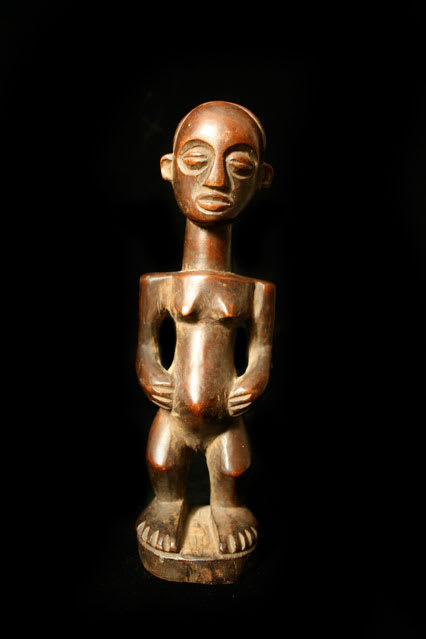Hemba Female Figure, 19th Century CE - 20th Century CE
wood
height 26 cm
height 10 1/4 in
height 10 1/4 in
DG.015 (LSO)
Further images
This elegant piece displays the best qualities of Hemba sculpture in a compact, well-modelled and well-preserved form. It constitutes a standing female figure with flexed knees and hips, full-square and...
This elegant piece displays the best qualities of Hemba sculpture in a compact, well-modelled and well-preserved form. It constitutes a standing female figure with flexed knees and hips, full-square and with her hands placed on her protuberant abdomen. Her limbs and the profiles of her body are a series of elegant curves, the most prominent parts of which are endowed with a glossy patina of age and use wear. The neck is tall and slender, topped with a supremely well-carved head with a very serene and reflective face. The coiffure is traditional, being posteriorly elongated in the form of four flanges surrounding a depression in the apex of the hair. Perhaps the most remarkable aspect of this piece is the superb patination and the deep colour of the wood.
The Hemba are an agriculturally-based group living on the banks of the Lualaba River, in what was once Zaire. They are arranged into large groups which approximate to clan, each of which has a common ancestor, and is headed by an elder known as the Fuma Mwalo. He is responsible for justice, receives tribute from his subordinates; his power is counterbalanced by secret societies called Bukazanzi (for men) and Bukibilo (for women). One of his other tasks is holding socially important sculptures that represent ancestors, the guiding force for much of Hemba society.
As stated, most sculptures pertain to ancestor worship, and it is notable that the Luba – with which the Hemba were long considered to be contiguous – have a similar system and presumably therefore a common ancestry. Their works can usually be differentiated, however, on the basis of carving subtlety, as well as – although something of a subjective measure – the quality of detailing, the serenity of expression and the somewhat impassive quality of most Hemba pieces. One of the very few indigenous artists known specifically to western art historians was a member of the Hemba group; the “Master of Buli” is known for his unique rendering of human features in an elongated, somewhat simian manner. Masks are very rare – there are two types, the significance of which is currently unclear. In addition to prestige items such as stools, staffs and the like, there are three main types of figures. Ancestor statues are called Singiti, and are usually male. Warrior figures are uncommon, and resemble ancestors except for the fact that they are carrying weapons. Janus figures called Kabeja are kept by the Fumu Mwalo of each group, and are worshipped as the embodiment of protector spirits. Female sculptures are rarer, and are associated with fertility, and also sometimes with paraphernalia used for divination and soothsaying.
This is an attractive and refined piece of African art, and would be a striking addition to any collection or sophisticated domestic environment.
The Hemba are an agriculturally-based group living on the banks of the Lualaba River, in what was once Zaire. They are arranged into large groups which approximate to clan, each of which has a common ancestor, and is headed by an elder known as the Fuma Mwalo. He is responsible for justice, receives tribute from his subordinates; his power is counterbalanced by secret societies called Bukazanzi (for men) and Bukibilo (for women). One of his other tasks is holding socially important sculptures that represent ancestors, the guiding force for much of Hemba society.
As stated, most sculptures pertain to ancestor worship, and it is notable that the Luba – with which the Hemba were long considered to be contiguous – have a similar system and presumably therefore a common ancestry. Their works can usually be differentiated, however, on the basis of carving subtlety, as well as – although something of a subjective measure – the quality of detailing, the serenity of expression and the somewhat impassive quality of most Hemba pieces. One of the very few indigenous artists known specifically to western art historians was a member of the Hemba group; the “Master of Buli” is known for his unique rendering of human features in an elongated, somewhat simian manner. Masks are very rare – there are two types, the significance of which is currently unclear. In addition to prestige items such as stools, staffs and the like, there are three main types of figures. Ancestor statues are called Singiti, and are usually male. Warrior figures are uncommon, and resemble ancestors except for the fact that they are carrying weapons. Janus figures called Kabeja are kept by the Fumu Mwalo of each group, and are worshipped as the embodiment of protector spirits. Female sculptures are rarer, and are associated with fertility, and also sometimes with paraphernalia used for divination and soothsaying.
This is an attractive and refined piece of African art, and would be a striking addition to any collection or sophisticated domestic environment.





